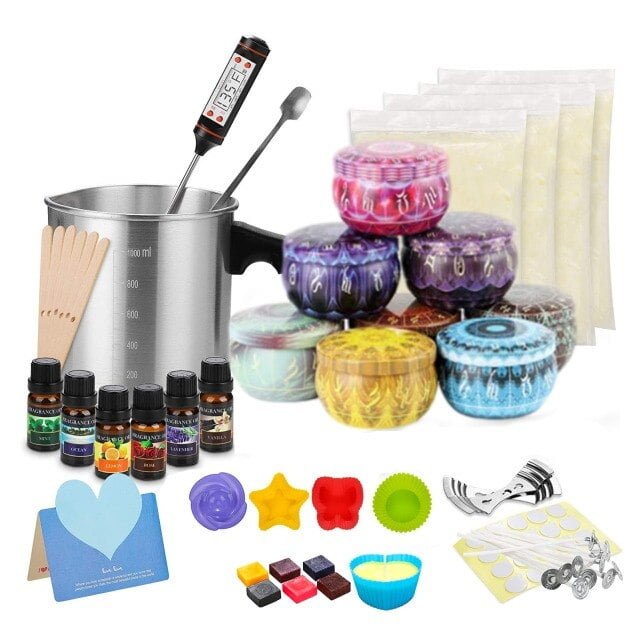Have you ever wondered what new substances are made when making a candle burn? The process of candle burning involves a fascinating chemical reaction that transforms the solid wax into gaseous byproducts. In this article, we will explore the chemistry behind the burning of a candle and the various substances that are produced during this process.
Candle burning is not just about creating light and ambiance; it is also a complex chemical process. Understanding the chemistry of candle burning can provide valuable insights into the composition of the materials used in making candles and the environmental impact of their use.
In this article, we will delve into the components of a candle, including wax, wick, and additives, as well as examine the process of combustion from solid to gas. We will also explore what happens to the wax molecules during burning and discuss the emission of carbon dioxide and water vapor.
Additionally, we will investigate the release of fragrance and scented oils, as well as the environmental impact of candle burning. Join us as we uncover the science behind this everyday phenomenon.
The Components of a Candle
When considering the components of a candle, it is important to understand the role that each element plays in the process of burning. The primary components of a candle include wax, a wick, and various additives. The type of wax used can vary, with paraffin wax being one of the most commonly utilized.
The wick, typically made of braided cotton, serves as the fuel delivery system for the flame. Additives such as colorants and fragrances are often included to enhance the aesthetic appeal and scent of the candle.
During the burning process, these components undergo a series of chemical changes that result in the release of energy in the form of light and heat. As the flame heats up the wax near the wick, it causes the wax to vaporize and react with oxygen in the air. This produces a variety of new substances, including carbon dioxide, water vapor, and soot.
One interesting aspect to consider is what new substances are made when making a candle burn. When wax burns, it undergoes a chemical reaction called combustion. This results in molecular changes within the wax molecules that ultimately produce several byproducts. In addition to carbon dioxide and water vapor, combustion also generates small amounts of volatile organic compounds (VOCs) depending on any additives present in the wax formulation.
| Component | Function |
|---|---|
| Wax | Primary fuel source for combustion |
| Wick | Delivers fuel to flame through capillary action |
| Additives | Enhances aesthetics and releases fragrance during burning |
The Process of Combustion
During the process of combustion, new substances are produced as a result of the chemical reaction. The primary products of candle burning are carbon dioxide (CO2) and water vapor (H2O), along with small amounts of other gases such as carbon monoxide (CO). These gases are released into the air as byproducts of the combustion process. Additionally, depending on the type of wax and additives used in the candle, there may be other substances emitted during burning.
One significant aspect to consider is that different types of candles can produce varying levels of soot and particulate matter during combustion. Soot is composed primarily of carbon particles that have not undergone complete combustion. The emission of soot and particulate matter can contribute to indoor air pollution and may have adverse effects on respiratory health over time.
| Substances Produced During Combustion | Effects on Indoor Air Quality |
|---|---|
| Carbon dioxide (CO2) and Water vapor (H2O) | May contribute to indoor air pollution |
| Soot, Particulate Matter | Potential adverse effects on respiratory health |
What Happens to the Wax Molecules During Burning
When a candle burns, the wax molecules undergo several chemical changes as they transform from a solid to a gas. Understanding these changes can provide valuable insights into the chemistry of candle burning. Here’s a closer look at what happens to the wax molecules during the process:
- Melting: The heat from the flame causes the solid wax to melt and form a pool of liquid wax around the wick.
- Vaporization: As the liquid wax near the wick heats up, it vaporizes and turns into a gaseous state. This gaseous wax then reacts with oxygen in the air.
During this transformation, several new substances are created as a result of the chemical reactions taking place. These include carbon dioxide, water vapor, and potentially soot and other particulate matter. Additionally, depending on whether scented oils or additives are present in the wax, specific fragrances or chemicals may also be released into the air.
As such, understanding what new substances are made when making a candle burn is essential for assessing both the environmental impact of candle burning and its potential health effects. It also sheds light on how different types of candles or additives can influence air quality and indoor environments.
The Emission of Carbon Dioxide and Water Vapor
During the process of burning a candle, several chemical reactions take place that result in the production of new substances. One of the main products of candle burning is the emission of carbon dioxide and water vapor. When a candle burns, the heat from the flame vaporizes the candle wax, breaking down its molecular structure and releasing carbon dioxide and water vapor into the air.
The chemical reaction that occurs during candle burning can be described by the formula CxHy + (x+y/4)O2 – > xCO2 + (y/2)H2O, where CxHy represents the hydrocarbons found in the wax. This equation illustrates how the combustion of hydrocarbons in the presence of oxygen leads to the formation of carbon dioxide (CO2) and water vapor (H2O). These gases are released into the surrounding environment as byproducts of candle burning.
It is important to note that while carbon dioxide and water vapor are natural byproducts of combustion, excessive exposure to these gases can have environmental implications. In poorly ventilated areas, prolonged exposure to high levels of carbon dioxide can lead to health concerns.
Additionally, when candles are burned in enclosed spaces without proper ventilation, they can contribute to an increase in indoor humidity levels due to the release of water vapor. Understanding these chemical processes sheds light on how candle burning can impact both indoor air quality and overall environmental conditions.
Soot and Particulate Matter
When a candle burns, it undergoes a chemical reaction that results in the formation of several new substances. One of these by-products is soot, which is comprised of tiny carbon particles that are emitted into the air during the combustion process. The release of soot and other particulate matter can have negative effects on both indoor air quality and human health.
Composition of Soot
Soot is formed when the carbon-containing compounds in the candle’s wax do not fully combust, leading to the creation of small, solid particles. These particles can vary in size and composition depending on the type of wax used in the candle, as well as any additives or fragrances present. In addition to carbon, soot may also contain trace amounts of other elements such as sulfur and nitrogen, which contribute to its potential harmful effects.
Health Concerns
The release of soot and particulate matter during candle burning can pose health risks, especially for individuals with respiratory conditions such as asthma or allergies. Inhaling these tiny particles can irritate the lungs and airways, leading to symptoms such as coughing, wheezing, and shortness of breath. Long-term exposure to airborne pollutants like soot has also been linked to more serious health issues such as cardiovascular disease and lung cancer.
Preventing Soot Formation
To minimize the amount of soot produced during candle burning, consider using candles made from cleaner-burning waxes such as soy or beeswax. Trimming the wick to a proper length before lighting the candle can also help promote more complete combustion of wax molecules and reduce sooting. Additionally, ensuring proper ventilation in the area where candles are being used can help disperse airborne particles and improve indoor air quality.
The Release of Fragrance and Scented Oils
When a candle burns, it not only produces heat and light, but it also releases fragrance and scented oils into the air. This process adds an extra dimension to the experience of burning candles, as it enhances the atmosphere and can create a pleasant aroma in a room. The release of fragrance and scented oils is an important aspect of candle burning that many people enjoy.
How Fragrance Is Released
The release of fragrance from a burning candle occurs when the heat from the flame vaporizes the scented oils within the wax. These vapors are then dispersed into the air, allowing the aroma to spread throughout the surrounding space. The intensity of the fragrance released can be impacted by factors such as the type and amount of scented oils used, as well as the size and composition of the wax.
The Chemical Changes
During this process, new substances are created through chemical reactions between the heat, wax molecules, and scented oils. The specific compounds produced will depend on the ingredients used in making the candle.
Generally speaking, when a candle burns, it undergoes combustion which transforms its components (wax and additives) into carbon dioxide, water vapor, soot particles, and other byproducts. Furthermore, fragrances that are formulated using essential oils or synthetic compounds will produce their own unique set of chemical changes when heated during burning.
The Environmental Impact of Candle Burning
When considering the environmental impact of candle burning, it’s essential to understand what new substances are created during this process. The release of various compounds into the air can have consequences for both indoor and outdoor air quality. Some of the key factors to consider regarding the environmental impact of candle burning include:
- Emission of carbon dioxide and other greenhouse gases: When a candle burns, it produces carbon dioxide as a byproduct of combustion. This adds to the overall levels of carbon dioxide in the atmosphere, contributing to climate change.
- Soot and particulate matter: Incomplete combustion of wax can lead to the formation of soot and other particulate matter. These tiny particles can be released into the air and have negative effects on indoor air quality. In addition, they can contribute to respiratory issues when inhaled.
- Release of volatile organic compounds (VOCs): Many scented candles contain fragrances and oils that can release VOCs when burned. These compounds can contribute to indoor air pollution and have potential health impacts.
It’s important for consumers to be aware of these environmental impacts when using candles in their homes. Making informed choices about the type of candles used, how long they burn, and where they are placed can help minimize their environmental footprint.
By understanding what new substances are made when making a candle burn, individuals can take steps to reduce their impact on air quality and overall environmental health. This includes choosing cleaner-burning candles with natural waxes, avoiding heavily scented varieties, and practicing proper ventilation during candle use. Additionally, being mindful of how often candles are burned and properly extinguishing them when not in use can all contribute to reducing the environmental impact associated with candle burning.
Conclusion
In conclusion, the process of candle burning involves a complex interplay of chemical reactions that transform the solid wax and wick into gaseous byproducts. As the flame consumes the wax molecules, it produces new substances such as carbon dioxide and water vapor, which are released into the surrounding environment. Additionally, the emission of soot and particulate matter can pose potential health hazards and contribute to air pollution.
It is important to understand the chemical changes taking place during candle burning in order to appreciate its environmental impact. While candles provide aesthetic and aromatic benefits, their combustion releases carbon dioxide and other pollutants into the atmosphere. Furthermore, scented candles may also emit additional chemicals from fragrances and scented oils, adding to the complexity of their environmental footprint.
As consumers, being aware of these chemical processes can help us make informed choices about the types of candles we use. Opting for clean-burning candles made from natural waxes and lead-free wicks can minimize the release of harmful substances into our indoor and outdoor environments. By understanding the chemistry behind candle burning, we can strive to enjoy their warm glow while being mindful of their potential impact on air quality and our health.
Frequently Asked Questions
What Products Are Produced When a Candle Burns?
When a candle burns, it produces several products. The first is carbon dioxide, which is a colorless and odorless gas. It also produces water vapor, which condenses into tiny droplets and creates the visible white smoke that we see when a candle burns. Additionally, candles produce heat and light as part of their combustion process.
What Chemicals Are Released When You Burn a Candle?
When a candle burns, it releases various chemicals into the air. The primary byproducts of this combustion are carbon dioxide (CO2) and water vapor (H2O). However, incomplete combustion can also lead to the release of carbon monoxide (CO), soot, and other volatile organic compounds. These emissions can contribute to indoor air pollution if candles are burned in poorly ventilated spaces.
What Is Created When a Candle Burns?
When a candle burns, it undergoes a chemical reaction known as combustion. The heat from the flame melts the wax near the wick, which is then drawn up into the wick where it is vaporized and combusted.
This process creates light and heat energy that we perceive as the flickering flame of a burning candle. Additionally, combustion also leads to the formation of water vapor and carbon dioxide as mentioned earlier.

Welcome to my candle making blog! In this blog, I will be sharing my tips and tricks for making candles. I will also be sharing some of my favorite recipes.





